[contentblock id=1 img=html.png]
Dallas Cowboys 31 – New York Giants 21
Both quarterbacks played well. This game was lost in the trenches. It really is that simple. The Dallas Cowboys out-played the Giants on the offensive and defensive lines. It’s hard to win football games when you are out-played up front. The Giants could not rush the football because the offensive line could not generate move out a subpar front seven that had struggled against the run. The Giants defensive line exerted virtually no pressure on the Cowboys quarterback and gave up 156 yards on the ground.
REVISITING: FOUR DOWNS
During our game preview, we listed ‘Four Downs,’ which took a look at the top four questions surrounding the Giants heading into the game. Now that the game has been played and the film reviewed, it’s time to break it down.
First Down
Can the defensive line and linebackers contain DeMarco Murray?
No. Murray rushed for 128 yards on 28 carries (4.6 yards per carry) and one touchdown.
Second Down
Can Dominique Rodgers-Cromarite play? Can he be effective?
DRC only played 15 defensive snaps, mostly on third down. In hindsight, the Giants would have been better off to have sit him.
Third Down
How will Justin Pugh respond?
Much better than a week ago versus Philly, but then again, it would have been hard to be worse. Aside from a penalty directed his way, Pugh held his own against the Dallas Cowboys. He wasn’t terribly great, but wasn’t terribly bad, either.
Fourth Down
Is Odell Beckham Jr. ready?
Beckham has yet to have his truly ‘breakout performance,’ and by breakout, its in reference to 100 or more receiving yards, eight or more catches, but Sunday was again another indication that the rookie is progressing. Beckham caught four passes for 34 yards and a pair of touchdowns as Manning looks to be targeting the rookie more and more. Beckham also rushed once for 13 yards.
OFFENSIVE OVERVIEW – by Connor Hughes
The Giants offense gained 352 total yards of offense versus Dallas, rushing for 104 and passing for 248. The team picked up 20 total first downs, held the ball for 26:11.
QUARTERBACK – by Connor Hughes
As has been the case against every opponent not nicknamed the ‘Detroit Lions,’ Eli Manning was very efficient versus the Cowboys. Manning completed 21-of-33 for 248 yards with three touchdowns and no interceptions. It marked the third straight game in which Manning did not throw an interception.
One of the more alarming observations from the game was the fact Manning and Co. have not attempted to stretch the field much this season. Of his 21 completions, Manning averaged just 7.5 yards per completion. Comparing that to Cowboys quarterback Tony Romo, who completed 17 passes, he averaged 12.1 yards per completion.
Manning has the weapons to stretch the field, but the team just isn’t looking to do it. With a running game that hasn’t truly got it going yet with Andre Williams in the backfield, it may be beneficial for Manning to take the shots.
Even if the pass is incomplete, the defense will need to respect the pass. The safety will need to come out of the box for fear of the deep bomb. With New York never even taking a shot, there’s no fear of anything past 10 yards.
RUNNING BACKS – by Connor Hughes
It’s tough to gauge exactly why Andre Williams is struggling to establish anything consistent on the ground: It could be the offensive line, could be Williams not seeing potential cutback lanes and strictly running where the ball is supposed to be. Discounting his 22 yard rush, Williams rushed 17 times for 29 yards (1.7 yards per carry).
When Rashad Jennings was in the game, rarely did he run strictly through the hole the play was designed for. While Jennings isn’t the strongest or fastest running back, he has tremendous vision. He could see the lane left when running right, and adjust his carries to compensate and pick up yardage. With Williams in the game, it doesn’t appear as if that’s the same case.
At times, it looks like Williams strictly runs through the hole the play is designed to go through. That works when the hole is there. When its not, Williams is tackled for no gain or a loss.
WIDE RECEIVERS – by Connor Hughes
Victor Cruz will be missed. That was evidently clear on Sunday. Yes, the Giants have Odell Beckham and need Beckham to step up, but Beckham isn’t replacing’ Cruz in the slot. That’s Preston Parker.
While Parker will play a role of if he’s open, he’s hardly a game-changer like Cruz. On Sunday, Parker caught just two passes for 19 yards.
The Giants had been hoping Rueben Randle would step up, but as this season has made clear, it doesn’t look as if Randle is a clear-cut No. 1 in the NFL. Hypothetically, Beckham – if he can establish to a No. 1 – with Randle on the other side and Cruz in the slot is a perfect receiving corps. Every player compensates for each other perfectly. The Giants would have one of everything at the three spots.
TIGHT ENDS – by Connor Hughes
Larry Donnell didn’t cost the Giants a game, but he contributed to the loss. While his seven catches for 90 yards were a nice breakout from the one catch in the previous two complete games, Donnell’s fourth quarter fumble cost the Giants their best chance at tying the game.
For as good as Donnell has been, he’s also lost three fumbles on his 33 touches. That’s not good.
Donnell gives the Giants a chance to stretch the field and is New York’s best receiving option at the position, so it’s unlikely New York benches him, but Daniel Fells is right now the more “sure” thing. Fells is the type of tight end that would have started for New York any year under Kevin Gilbride. He’s reliable, runs the right routes, and can get to spot A on the field when he’s supposed to be there.
When Fells is in the game, the Giants know what they’ll get out of him, but what Donnell does with his pure athletic ability are things Fells just can’t do. Donnell can’t come off the field, but he’s doing his part in trying to make it so he can.
Tom Coughlin has been a stickler for players who can’t hold on to the ball. One more fumble from Donnell may cost the tight end his No. 1 spot.
OFFENSIVE LINE – by Eric Kennedy
The Dallas Cowboys defense controlled the line of scrimmage. The Cowboys were the stronger, more physical team. That showed up most clearly in New York’s attempted ground attack. Coming into this game, the Cowboys defense had been surrendering 5.1 per carry. Take away runs by Eli Manning, Odell Beckham, and the one meaningless 9-yard run by Peyton Hillis at the end of the first half, and the Giants averaged 3.1 yards. Take away the one 22-yard run by Andre Williams, and the Giants averaged 2.2 yards on 24 carries. Given the fact that the Giants only ran 59 offensive plays in the game, that means 41 percent of their snaps averaged 2.2 yards.
Who was the problem? It was across the board, and it just wasn’t always the offensive line. But the line did not win their one-on-one match-ups…even missing blocks away from the play and allowing backside defenders to disrupt the play. There were occasions where a player simply got beat (physical mistake), and other occasions where the defender making the play wasn’t blocked (mental mistake).
Pass protection was better in that Manning was not sacked and only officially hit three times. But keep in mind that Dallas is a terrible team at rushing the passer (only six sacks all season) and that Eli again made his protection look better than it was due to quickly getting rid of the ball. It’s pretty clear that in some instances, Tom Coughlin and Ben McAdoo simply don’t trust the line and/or their quarterback in very long down-and-distance situations as New York continues to run the ball even on third and long.
As troubling as the inability to run the football against a weak defensive front was, penalties were also a huge problem. I’ve pointed out in our Giants-Redskins game review that the short passing game in the West Coast Offense can be a thing of beauty as long you don’t suffer any setbacks on 8-12 play drives. But a penalty, sack, or negative run can stymie a drive. Teams only have so many possessions per game. Not counting the two meaningless drives at the end of the half and game, the Giants had nine offensive possessions against the Cowboys. The Giants scored touchdowns on three of those drives (one-third). They overcame a holding call on Will Beatty on one of these drives.
But on three other possessions, penalties put a halt to things:
- False start on Will Beatty on a 4th-and-1 attempt. Punt.
- False starts by Justin Pugh and Weston Richburg, the latter on 2nd-and-13. Punt.
- Not the OL, but Rueben Randle offensive holding on 1st-and-10 on Dallas 40-yard line. Punt.
What about the other three drives?
- First possession of the game, after two runs, the Giants face 3rd-and-11 and hand-off to “speedster” Peyton Hillis for four yards. Punt. That’s the same as surrendering on 3rd-and-11. Not a very brave message to your team to start the game.
- Near the 2-minute warning in the first half, after two runs picked up 6 yards, Eli could not connect with WR Preston Parker on 3rd-and-4. Punt.
- Early in the 4th quarter, Eli connected with TE Larry Donnell for the first down, but Donnell fumbled the ball away.
In my opinion, Dallas never really “stopped” the Giants passing game. But penalties and an inability to run the football prevented the Giants from doing even more damage than the 21 points they accrued.
DEFENSIVE OVERVIEW – by Eric Kennedy
The expectations coming out of training camp were that the defense was the far more settled portion of the team, with no turnover on the entire defensive coaching staff, same system, and an infusion of talent into what was going to be one of the best secondaries in the league. The Giants defense dominated its offensive counterpart throughout camp and there was talk of this being a top five unit.
But the same old problems remain.
In five seasons under defensive coordinator Perry Fewell, the Giants defensive rankings in terms of yards allowed are as follows:
- 2010: 7th
- 2011: 27th
- 2012: 31st
- 2013: 8th
- 2014: 25th
Defensive rankings, points per game:
- 2010: 17th
- 2011: 25th
- 2012: 12th
- 2013: 18th
- 2014: 21st
There is a whole lot of mediocrity there. Even when the yardage totals were respectable (2010 and 2013), the points per game totals were not. And it’s the same shit each year: blown coverages, blitz packages that rarely if ever produce, an inability to get off the field on third down, and an inability to make key stops in critical situations.
When the parts change but the results don’t, that suggests coaching is an issue.
That said, Perry Fewell once again has a built-in excuse to save his butt. The Giants lost their top nickel corner (Walter Thurmond) and his replacement (Trumaine McBride). The team’s #1 free agent acquisition (Dominique Rodgers-Cromartie) can’t stay on the field and isn’t producing as expected. There was a major downgrade at free safety with the release of Will Hill. And Jon Beason has been more of a liability than asset with his foot issue. Personnel matters too. And simply put, the Giants are not good enough on defense. The defensive line is not getting to the quarterback. The linebackers are below average. And the secondary is beat up and underperforming.
Perry Fewell and his defensive team looks great when they face someone like Kirk Cousins or Josh Freeman, but the results are usually pretty bad when they face a quality NFL starter.
As for this particular game, the numbers – once again – tell the story. The Cowboys accrued 20 first downs and 423 yards of offense, including 156 yards on the ground. Dallas was 9-of-14 on third down (an unacceptable 64 percent). Dallas controlled the clock 33:49 (to Giants’ 26:11). The Cowboys were 3-for-3 (100 percent) in the red zone. QB Tony Romo only had 6 incompletions, and none in the second half of the game where he was a perfect 9-for-9. Dallas also had six plays over 20 yards totaling 162 yards.
Dallas scored on half of their possessions: four touchdowns and a field goal on 10 opportunities. Their first three touchdown drives went 76 yards in 11 plays, 80 yards in 10 plays, and 93 yards in 6 plays. When the Giants got to within 28-21 with 5:28 to play, the defense could not stop the Cowboys, allowing Dallas to to pick up three first downs and 49 yards, erasing 4:29 from the clock, and setting up the game-clinching field goal. On these five scoring drives, Dallas converted on 3rd-and-8, 3rd-and-5, 3rd-and-10, 3rd-and-6, 3rd-and-9, 3rd-and-6, 3rd-and-8, and 3rd-and-1.
Coming into this game, the Giants game-plan had to be to limit the damage of RB DeMarco Murray, WR Dez Bryant, and TE Jason Witten. Murray rushed for 128 yards and a touchdown (4.6 yards per carry). Bryant caught 9 passes for 151 yards (16.8 yards per catch). In other words, 279 of Dallas’ 423 yards were by these two players. The Giants were able to limit the damage of Witten (2 catches for 27 yards), but were burned by his backup (3 catches for 65 yards and two touchdowns). Romo completed 17-of-23 passes for 279 yards and three touchdowns. His QB rating was a gaudy 135.7.
DEFENSIVE LINE – by Eric Kennedy
Jason Pierre-Paul (60 snaps, 6 tackles, 2 sacks, 3 tackles for a loss, 3 quarterback hits) and Mathias Kiwanuka (55 snaps, 2 tackles) saw the bulk of the playing time at defensive end. Cullen Jenkins (1 quarterback hit) left the game with an injury after playing only 11 snaps at defensive tackle. Because of that, Johnathan Hankins (40 snaps, 3 tackles), Mike Patterson (32 snaps, 2 tackles), and Markus Kuhn (23 snaps, 1 tackle) saw the most action at defensive tackle.
DE/DT Robert Ayers (19 snaps, 1 tackle) and DE Damontre Moore (10 snaps, 0 tackles) saw more limited time.
The Giants gave up 102 rushing yards (6 by Romo) in the first half alone. That said, there were times when they did a nice job on the Cowboys running game. JPP and Hankins stood out at times against the run and both caused holding penalties that helped to stop two first-half drives. The left side of the defensive line – Mathias Kiwanuka and Cullen Jenkins – were two who had issues in run defense.
The bulk of Murray’s 73 first-half yards came in big chunks as he had runs of 17, 10, and 21 yards – accounting for 66 percent of his production. Other than those three runs, the Giants actually did a decent job on him. Unfortunately, those three runs do count.
On 2nd-and-9 on first TD drive, Murray picks up 17 yards as Beason (blocked by #72), Jenkins (blocked by #70), and Kiwanuka (blocked by #78) were effectively handled at the point of attack. Murray has a huge hole to run through.
On 1st-and-10 on second TD drive, the Giants are in good position to stop Murray, but Devon Kennard is stiff-armed and a 10-yard gain results.
On 1st-and-10 on same drive, Murray picks up 21 yards as Dallas runs at Kiwanuka and Kennard.
In the second half, most of Murray’s damage/impact again came on three runs:
- A 15-yard gain when Patterson, McClain, and Kuhn were blocked.
- An 8-yard run on 3rd-and-1 when the Cowboys were trying to run out the clock.
- A 17-yard cutback run on the very next snap where either Kiwanuka and/or Kennard appeared to lose contain.
But the big problem wasn’t the run defense, there was no pass rush. JPP had two good pressures, one resulted in an incompletion on what could have been a 57-yard TD pass (that’s what pressure does). And he had a very nice sack against Pro Bowl LT Tyron Smith late in the first half. His early sack was more of a coverage sack/snafu by Romo than an actual good pass rush. Other than that, it was like Romo was playing 7-on-7 back there as he was rarely even disturbed. The few times Fewell blitzed, it didn’t get there, and there were times when the pass rush was minimized by dropping linemen into coverage (i.e., Jenkins was dropped into coverage on the 3rd-and-5 play that resulted in a 24-yard completion to TE Gavin Escobar).
Just one example where Romo had all day to throw was his 18-yard touchdown pass to WR Terrance Williams. The Giants had good coverage on the play, but Romo had all day to find a receiver who would eventually get open. On this play, the Giants initially rushed four, but Markus Kuhn got stymied at the line and then peeled off to cover the running back.
There was no pressure on Romo at all in second half as he completed all nine of his attempts (again, it was like a 7-on-7 drill).
What really bugs me is dropping defensive linemen into coverage. Maybe I’m looking at the wrong plays, but this never seems to work. Look where the Giants’ best pass rusher (#90) is on the 44-yard completion on 3rd-and-6 in the third quarter.
LINEBACKERS – by Eric Kennedy
Jon Beason was only able to last 17 snaps before being forced to leave the game with his never-ending toe issue. It’s time to shut him down, put him on IR, and let him have surgery. He wasn’t very good when he played (no tackles). He was effectively blocked at the point-of-attack (see 17-yard run above) and looked a step slow in coverage (Escobar’s 24-yard completion on 3rd-and-5). The team plays better with Jameel McClain inside.
Jacquian Williams (62 snaps, 7 tackles) saw the most action, followed by McClain (53 snaps, 5 tackles, 1 tackle for a loss), and Devon Kennard (22 snaps, 4 tackles). Williams gave up a 12-yard completion to Witten on 3rd-and-8 on the first TD drive, but the Giants did a good job of keeping Witten under wraps and Williams probably deserves a lot of credit there. I’d like to see more of Kennard, but he did get stiff-armed on the 10-yard run and blocked on the 21-yard on the second TD drive.
DEFENSIVE BACKS – by Eric Kennedy
The main four in this contest were Antrel Rolle (62 snaps, 3 tackles), Quintin Demps (61 snaps, 6 tackles), Prince Amukamara (59 snaps, 7 tackles 1 interception, 2 pass defenses), and Zack Bowman (45 snaps, 5 tackles, 1 pass defense).
Stevie Brown (0 tackles), Jayron Hosley (1 tackle), and Dominique Rodgers-Cromartie (1 tackle) chipped in with 15 snaps apiece. Chandler Fenner saw four snaps.
Tony Romo’s one interception came on a play where Dez Bryant fell down. The Giants only defended three passes as Tony Romo only threw six incompletions, and was a perfect 9-for-9 in the second half. It doesn’t get much worse than that.
Plays that stood out me included:
- Jayron Hosley and DRC holding Bryant 1-yard short of the first down on 3rd-and-8.
- Bowman’s excellent deep coverage on WR Terrance Williams.
- Demps missing Romo on a safety blitz.
- Either Hosley or Beason badly busting coverage on Escobar’s 15-yard TD reception on 3rd-and-10 (seems to happen far too often in Fewell’s defenses).
- Amukamara having excellent coverage on Bryant on a perfectly-thrown 8-yard slant on 3rd-and-6. A few plays later, Amukamara got beat deep by Bryant, but he recovered in time to knock away Romo’s under thrown ball (one of few times Romo was pressured).
- A typical Fewell zone special where Romo was provided with an easy pitch-and-catch opportunity to his security blanket (Witten) on 3rd-and-9 on the second TD drive.
In the second half, it was worse, again with no incompletions for the Cowboys.
Chandler Fenner was completely lost when attempting to cover Bryant out of the slot on 3rd-and-6, resulting in a game-changing 44-yard completion. On this play, Fenner and Demps also missed the tackle after the completion.
Two plays later, Amukamara was beat by Bryant for an easy 17-yard completion.
On the next snap, all of the linebackers bit on the play-action fake and Bowman was beaten by Escobar for a 26-yard touchdown on a very well-thrown pass. Demps, for some reason, did not smash Escobar as he came down with the throw. This 6-play, 93-yard drive put the Cowboys up for good and all of the damage was done on these three plays.
Amukamara continued to have issues with Bryant on other second-half possessions. He gave up a completion of 23 yards in the 3rd quarter. In the 4th quarter, on 3rd-and-8, Bryant beat Amukamara’s jam for a 24-yard completion down to the 1-yard line. Late in the game with the Giants trailing 28-21 and desperately trying to get the ball back, Bryant beat Prince for gains of 10 and 13 yards.
Antrel Rolle was invisible. He’s not playing like he did last year. If he doesn’t turn it around, this may be his last season with the team.
SPECIAL TEAMS – by Eric Kennedy
Special teams were not an issue in this game.
Steve Weatherford punted five time, averaging 44.8 yards per punt (39.6 net). Dallas only returned two punts for six yards. All four of Josh Brown’s kickoffs resulted in touchbacks as Dallas never returned a kickoff.
Michael Cox returned three kickoffs for 87 yards (29 yards per return) with a long return of 40 yards. Odell Beckham returned two punts for 21 yards, with a long of 13 yards.
In terms of return yardage, the Giants out-gained the Cowboys 108 to 6.

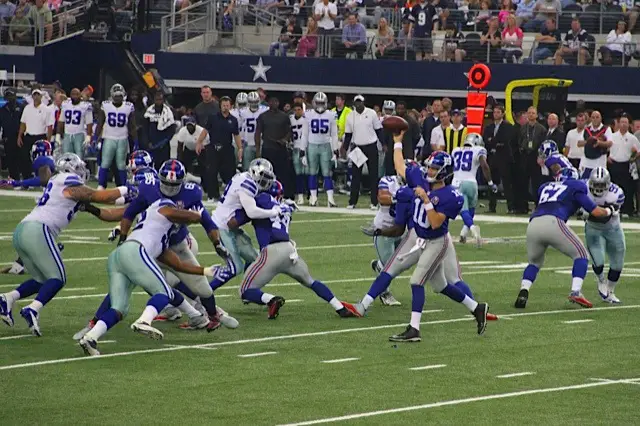
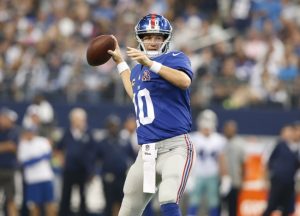
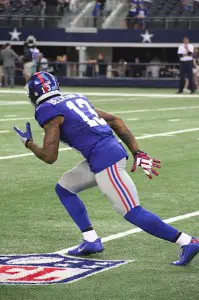
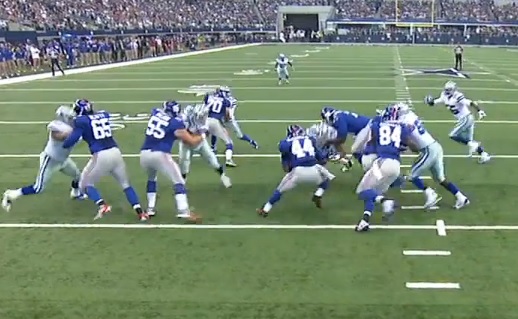
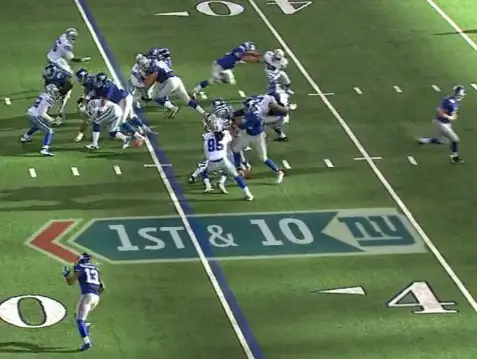
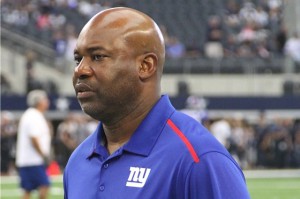
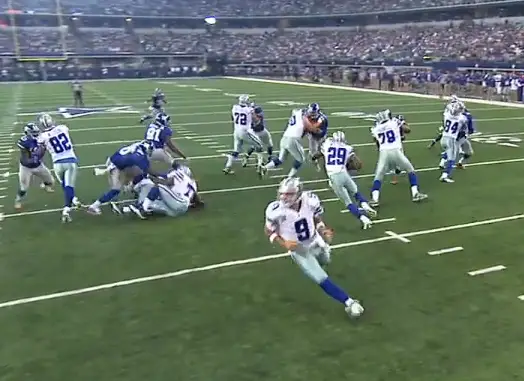
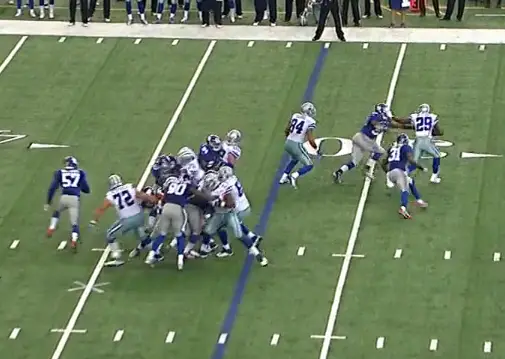
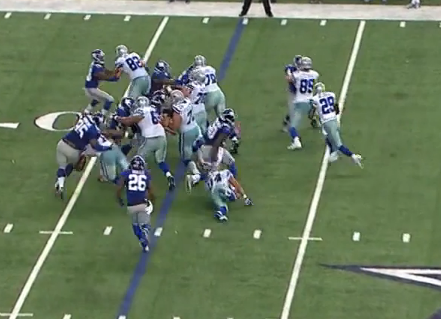
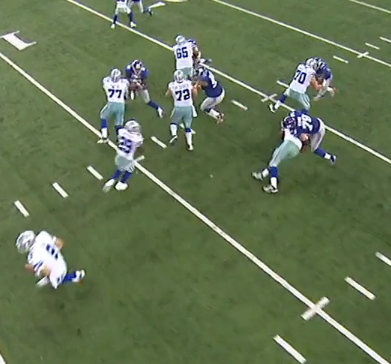
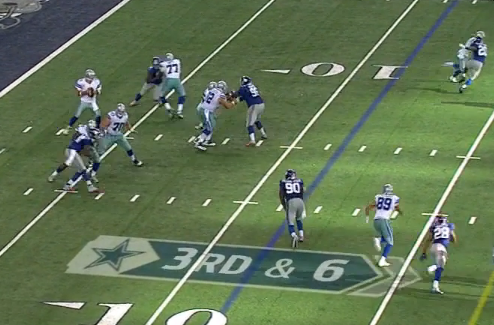
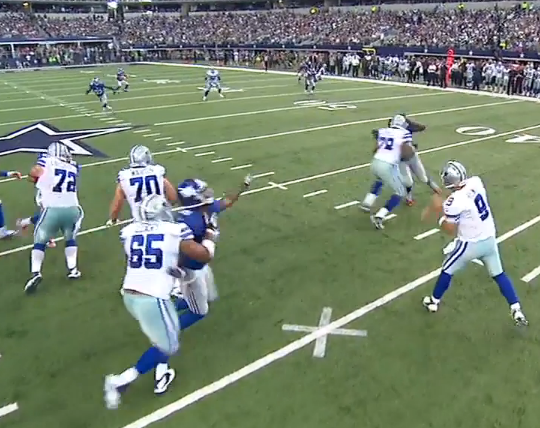

Sorry, the comment form is closed at this time.